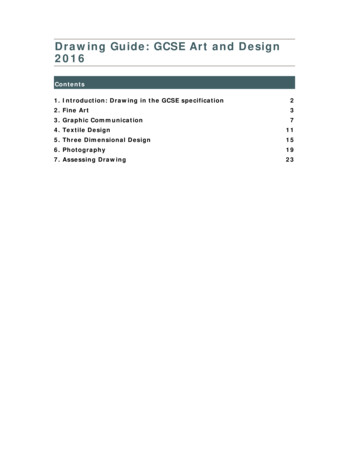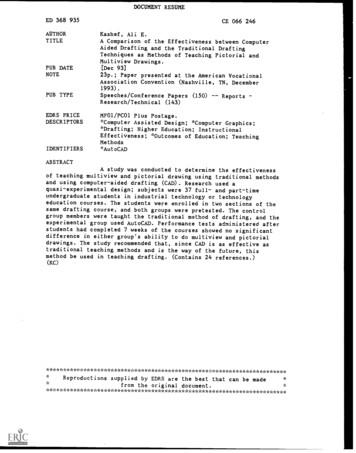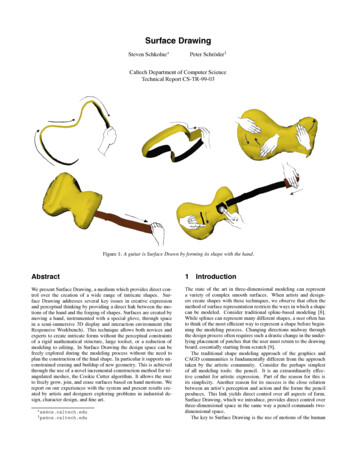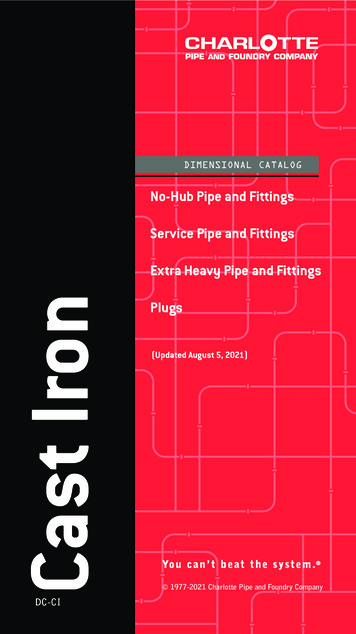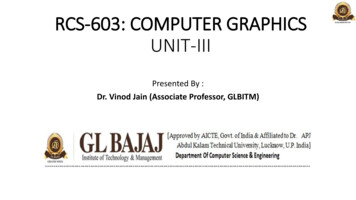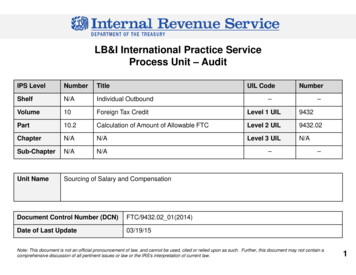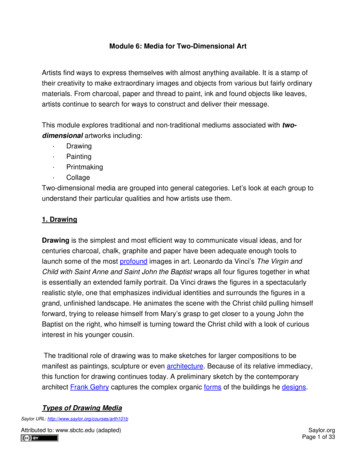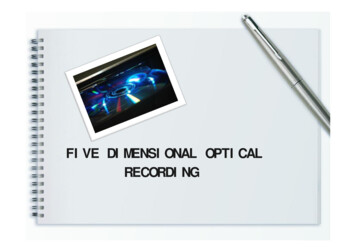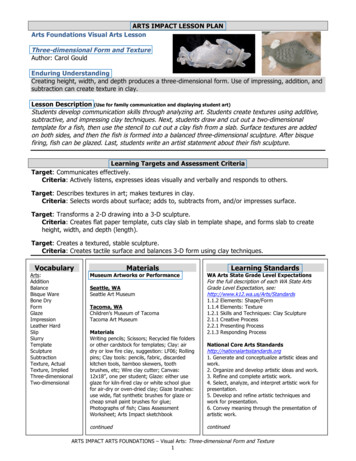
Transcription
ARTS IMPACT LESSON PLANArts Foundations Visual Arts LessonThree-dimensional Form and TextureAuthor: Carol GouldEnduring UnderstandingCreating height, width, and depth produces a three-dimensional form. Use of impressing, addition, andsubtraction can create texture in clay.Lesson Description (Use for family communication and displaying student art)Students develop communication skills through analyzing art. Students create textures using additive,subtractive, and impressing clay techniques. Next, students draw and cut out a two-dimensionaltemplate for a fish, then use the stencil to cut out a clay fish from a slab. Surface textures are addedon both sides, and then the fish is formed into a balanced three-dimensional sculpture. After bisquefiring, fish can be glazed. Last, students write an artist statement about their fish sculpture.Learning Targets and Assessment CriteriaTarget: Communicates effectively.Criteria: Actively listens, expresses ideas visually and verbally and responds to others.Target: Describes textures in art; makes textures in clay.Criteria: Selects words about surface; adds to, subtracts from, and/or impresses surface.Target: Transforms a 2-D drawing into a 3-D sculpture.Criteria: Creates flat paper template, cuts clay slab in template shape, and forms slab to createheight, width, and depth (length).Target: Creates a textured, stable sculpture.Criteria: Creates tactile surface and balances 3-D form using clay techniques.VocabularyArts:AdditionBalanceBisque WareBone DryFormGlazeImpressionLeather HardSlipSlurryTemplateSculptureSubtractionTexture, ActualTexture, seum Artworks or PerformanceSeattle, WASeattle Art MuseumTacoma, WAChildren’s Museum of TacomaTacoma Art MuseumMaterialsWriting pencils; Scissors; Recycled file foldersor other cardstock for templates; Clay: airdry or low fire clay, suggestion: LF06; Rollingpins; Clay tools: pencils, fabric, discardedkitchen tools, bamboo skewers, toothbrushes, etc; Wire clay cutter; Canvas:12x18”, one per student; Glaze: either useglaze for kiln-fired clay or white school gluefor air-dry or oven-dried clay; Glaze brushes:use wide, flat synthetic brushes for glaze orcheap small paint brushes for glue;Photographs of fish; Class AssessmentWorksheet; Arts Impact sketchbookcontinuedLearning StandardsWA Arts State Grade Level ExpectationsFor the full description of each WA State ArtsGrade Level Expectation, see:http://www.k12.wa.us/Arts/Standards1.1.2 Elements: Shape/Form1.1.4 Elements: Texture1.2.1 Skills and Techniques: Clay Sculpture2.1.1 Creative Process2.2.1 Presenting Process2.1.3 Responding ProcessNational Core Arts Standardshttp://nationalartsstandards.org1. Generate and conceptualize artistic ideas andwork.2. Organize and develop artistic ideas and work.3. Refine and complete artistic work.4. Select, analyze, and interpret artistic work forpresentation.5. Develop and refine artistic techniques andwork for presentation.6. Convey meaning through the presentation ofartistic work.continuedARTS IMPACT ARTS FOUNDATIONS – Visual Arts: Three-dimensional Form and Texture1
Seattle Art Museum images:Prestige Hat, 20th century, AnonymousCameroonian artist, 81.17.755Tacoma Art Museum images:Achilles’ Baptism in the River Styx, 1996,Patti WarashinaNational Core Arts Standards (continued)7. Perceive and analyze artistic work.8. Interpret intent and meaning in artistic work.9. Apply criteria to evaluate artistic work.10. Synthesize and relate knowledge andpersonal experiences to make art.11. Relate artistic ideas and works with societal,cultural, and historical context to deepenunderstanding.Early Learning Guidelines (Pre-K – Grade 3)For a full description of Washington State EarlyLearning and Child Development Guidelines Age 4-5) 3. Touching, seeing, hearing andmoving around: delight in playing with materialsof different texture.6. Learning about my world: Math: match andsort simple shapes. Arts: show an increasingability to use art materials safely andwith purpose.Common Core State Standards (CCSS) inELA For a full description of CCSS Standards bygrade level s/SL.CCR.2. Integrate and evaluate informationpresented in diverse media and formats, includingvisually, quantitatively, and orally.L.K-1.5.c. & L.2.5.a. Identify real-life connectionsbetween words and their use.Common Core State Standards (CCSS) inMath For a full description of CCSS Standards bygrade level /default.aspxK.G.3. Identify shapes as two-dimensional orthree-dimensional.Leroy, the Big Pup, 2004, Scot FifeARTS IMPACT ARTS FOUNDATIONS – Visual Arts: Three-dimensional Form and Texture2
ICON KEY:3 Indicates note or reminder for teacherþ Embedded assessment points in the lessonPre-TeachSearch for, feel, and describe textures found in the classroom andschool environment.Lesson Steps Outline1. Introduce and guide art analysis of the concept of texture of Prestige Hat by a20th century anonymous Cameroonian artist from Seattle Art Museum collectionand Achilles’ Baptism in the River Styx by Patti Warashina and Leroy, the Big Pupby Scott Fife from Tacoma Art Museum collection.Emphasize effective communication visually and verbally. Facilitate studentgroups/pairs in responding by generating words to describe actual textures inworks of art.þ Criteria-based student and teacher checklist: Actively listens, expresses ideasverbally and responds to others. Selects words about surface (in works of art).2. Introduce the concept of creating texture by impressing found objects, takingaway clay, and adding clay to a surface. Guide students in experimenting withcreating texture.þ Criteria-based process assessment: Actively listens, expresses ideas visuallyand verbally and responds to others. Selects words about surface; adds to,subtracts from, and/or impresses surface.3. Introduce the concept of two-dimensional vs. three-dimensional art.Guide students in drawing and cutting out a two-dimensional fish template withheight and width. Demonstrate and guide rolling clay slabs.þ Criteria-based teacher checklist: Creates flat paper template.ARTS IMPACT ARTS FOUNDATIONS – Visual Arts: Three-dimensional Form and Texture3
4. Demonstrate how to lay the template on a slab of clay and cut around thetemplate with a bamboo skewer. Guide students in cutting clay and creatingtextured surfaces.þ Criteria-based teacher checklist: Cuts clay slab in template shape. Createstactile surface.5. Demonstrate and guide bending the clay to create a free standing sculpture.þ Criteria-based teacher checklist, self-assessment: Forms slab to create height,width, and depth (length). Balances 3-D form using clay techniques.6. Facilitate peer reflection and self-assessment. Guide students in creating artiststatements.þ Criteria-based teacher checklist, peer and self-assessment and reflection:Actively listens, expresses ideas visually and verbally and responds to others.Selects words about surface.7. Direct students to arrange exhibition of fish sculptures and correspondingartist statements. Lead critique and self and peer-review.þ Criteria-based teacher critique, self and peer reflection: Actively listens,expresses ideas visually and verbally and responds to others. Describes creatingtextures. Shares challenges of creating balance and 3-dimensionality.After Bisque FiringGuide students in choosing safe glaze colors and demonstrate glazing techniques.Facilitate as students glaze sculptures.ARTS IMPACT ARTS FOUNDATIONS – Visual Arts: Three-dimensional Form and Texture4
LESSON STEPS1. Introduce and guide art analysis of the concept of texture of Prestige Hat bya 20th century Anonymous Cameroonian artist from Seattle Art Museumcollection and Achilles’ Baptism in the River Styx by Patti Warashina and Leroy,the Big Pup by Scott Fife from Tacoma Art Museum collection.Responding to Art inthe Classroom3 The Seattle Art Museum’s collection is available on-line museum.asp. To find the images in this lesson,enter the accession number for the work of art in the search box on the collections page of SAM’swebsite. Accession numbers for these works of art are listed in the materials box at the beginning ofthe lesson.ARTS IMPACT ARTS FOUNDATIONS – Visual Arts: Three-dimensional Form and Texture5
3 The Tacoma Art Museum’s collection is available on-line ons. The way something feels when we touch it is called texture. Sometimes texture is implied usingpainting techniques or other two-dimensional representation, but today we are going to createactual texture that we can see and feel.Emphasize effective communicating: visually and verbally. Facilitate student groups/pairsin responding by generating words to describe actual textures in works of art.3 Teacher can designate student groups or pairs. Communicating well in a group means that you are actively and respectfully listening andresponding to others. As a group/pair talk about what you see. Choose 3-5 words to describe textures in one or moreworks of art that you have discussed. Write them down on your assessment worksheet.3 Teacher can record texture words on collective word wall for future reference when students writeartist statements. Share your descriptive words with the class.þ Criteria-based student and teacher checklist: Actively listens, expresses ideas verbally and respondsto others. Selects words about surface (in works of art).ARTS IMPACT ARTS FOUNDATIONS – Visual Arts: Three-dimensional Form and Texture6
2. Introduce the concept of creating texture by impressing found objects,taking away clay, and adding clay to a surface. Guide students in experimentingwith creating texture. Clay tools and found objects create different and unique marks on the clay.Watch how I can use the tip, side, and eraser of a pencil to create marks. My fingers are my ten best pottery tools for smoothingand adding. A toothbrush can also be handy for the slip and slurrytechnique (lightly scrub the clay with the tooth brush, addinga tiny amount of water to join pieces together). I know thepieces are secure when I have “no seams.” Clay will take on the texture and pattern of anything that Ipress into it. Watch as I lay a piece of lace (burlap, netting,cardboard) on to the surface and apply pressure. Here I amusing clay tools to subtract clay from a surface and maketextural marks. Make two or three small textured “tiles” of clay by adding,subtracting, and impressing into the clay. Talk with a partner about the different textures you created.Share words describing the textures and describe how youcreated them.Clay TechniquesPart 1þ Criteria-based process assessment: Actively listens, expresses ideas visually and verbally andresponds to others. Selects words about surface; adds to, subtracts from, and/or impresses surface.ARTS IMPACT ARTS FOUNDATIONS – Visual Arts: Three-dimensional Form and Texture7
3. Introduce the concept of two-dimensional vs. three-dimensional art. What does 3-D mean? (height, width, and depth). What do you notice about 3-D art vs. 2-D art? (The 3-D can be viewed fromdifferent sides and perspectives). What are the concerns of an artist creating a sculpture? (Remember that theart will be viewed from many sides; it needs to be stable – balanced, so it doesnot tip over.)Prompting for CreativityGuide students in drawing and cutting out a two-dimensional fish template with heightand width. Look at and reflect on various 2-D fish images. Draw a fishshape on a file folder (lighter paper can be used) for atemplate. Cut out the template to the size that will fit wellonto a slab of clay. Think about what kind of fish you are creating. Is itinvented? Real? What sort of waters does it live in? Ocean, lake, river, pond?Demonstrate and guide rolling clay slabs.3 Show how to roll a slab using a rolling pin and canvas board (orroll outslabs ahead for each student). The important piece is that therolling pin isused in one direction only so that the slab does not fold up and ontothe roller.Flip the slab every three or four rolls.3 If air-dry clay is used, it is important that the slab be at least ½” thick. Clay that will be fired in a kilncan be rolled thinner.þ Criteria-based teacher checklist: Creates flat paper template.ARTS IMPACT ARTS FOUNDATIONS – Visual Arts: Three-dimensional Form and Texture8
4. Demonstrate how to lay the template on a slab of clay and cut around thetemplate with a bamboo skewer. Guide students in cutting clay and creatingtextured surfaces.Clay TechniquesPart 2 Watch as I carefully draw around my template with my cutting tool. I can nowremove the excess clay and save it as I will need extra to add to my sculpture. I will now use the texture techniques to communicate the surface I want to express and addinterest to both sides of my fish. Remember, you can take clay away (subtract), add, or makeimpressions on the clay. Cut out your fish and begin to texture both sides: impressing, adding, and subtracting clay.þ Criteria-based teacher checklist: Cuts clay slab in template shape. Creates tactile surface.ARTS IMPACT ARTS FOUNDATIONS – Visual Arts: Three-dimensional Form and Texture9
5. Demonstrate and guide bending the clay to create a free standing sculpture. Be careful that your clay is not thicker than the lower part ofyour thumb (rule of thumb) or thinner than the tip of yourpinky (rule of pinky). As you bend the clay, the piece becomes three-dimensionaland begins to have depth. Notice how forming the slab into a sculpture can enhance“fish” characteristics or traits; how fish move in water, theirparts, how they appear from different points of view. Making choices about how to enhance your sculpture’s fishlike characteristics is part of communicating visually. Check in with a friend to see if they have any suggestions forhow you can make your sculpture any more fish-like, or likethe fish you want to create. Is your fish a hungry fish, ahappy one, one that has bold textures or subtle ones? Whatare you trying to emphasize or express inyour fish? Really listen to your friends’ suggestions to see if there isanything you could do to make your sculpture bettercommunicate what you want it to. Make sure your sculpture is stable. Check to see that the sculpture is balancing on its own; finsor additions to the base might be necessary. Smoothing all surfaces is essential when usingclay; any piece that looks frayed or bumpy will fire to be rough and sharp.þ Criteria-based teacher checklist, self-assessment: Forms slab to create height, width, and depth(length). Balances 3-D form using clay techniques.ARTS IMPACT ARTS FOUNDATIONS – Visual Arts: Three-dimensional Form and Texture10
6. Facilitate peer reflection and self-assessment. Guide students in creatingartist statements. Use good communication skills by actively and respectfullylistening and responding. Talk about your art with a partner: This will help you writeyour artist statement. Describe what you have communicated in your sculpture. Is it an invented fish or a real fish? What water environment does it live in? Ocean, lake,river, pond? Does it have special traits (extra long tail, big teeth,wide fins)? Why?Complete your self-assessment checklist, answer reflectionquestions and write an artist statement in the lower part.þ Criteria-based teacher checklist, peer and self-assessment and reflection: Actively listens, expressesideas visually and verbally and responds to others. Selects words about surface.ARTS IMPACT ARTS FOUNDATIONS – Visual Arts: Three-dimensional Form and Texture11
7. Direct students to arrange exhibition of fish sculptures and correspondingartist statements. Lead critique and self and peer-review. Let’s take a gallery walk and look at the wonderful work we have created.Thoughtfully pause at each sculpture and read each artist statement. Let’s check to see that the surfaces are smoothed and thatthere are no visible “seams”. Reflect on your sculpture. What is the most interestingtexture on your sculpture? How did you create it? How did you make your sculpture balance? Did you encounter any challenges in making your 3-D form?How did you resolve it? Share observations about artists communicating visually in sculpture, and verbally in artiststatements. How do words help us understand the art more?Guiding Reflecting onStudent Artþ Criteria-based teacher critique, self and peer reflection: Actively listens, expresses ideas visually andverbally and responds to others. Describes creating textures. Shares challenges of creating balance and3-dimensionality.Notes about clay: At this point sculptures will dry and then be fired in a kiln to beglazed later or, if air-dry clay is used, a layer of sealer can be applied to make thesculpture stronger.Using a KilnImportant Clay terms:Leather hard: Clay after a few hours of drying. It can be carved into and is firm to the touch.Bone dry: Clay after a few days of drying. It is very fragile and ready to fire. It should not behandled by students at this stage.Bisque ware: Clay after the first firing, usually to cone 04 or 05 (1850 degrees). Bisque warecan be safely handled by students as it is rock-like and durable. The project is now ready to bepainted with glaze and fired a second time. Bisque ware can be painted with acrylic paint andsprayed with a fixative if glazing and a second firing are not needed. It will, however, not befood safe without the second firing.ARTS IMPACT ARTS FOUNDATIONS – Visual Arts: Three-dimensional Form and Texture12
After Bisque FiringGuide students in choosing safe glaze colors and demonstrate glazing techniques.Facilitate as students glaze sculptures. Glaze is similar to paint except that it contains silica (fine particles of glass) and will melt at hightemperature. Glaze finishes and seals your project. This is the same process that all pottersaround the world use to create sculptures and functional ware such as eating andcooking vessels. Glaze can be brushed on or applied by dipping. The bottom of a sculpture or pot must becarefully cleaned so that no glaze remains on the surface that will come in contact with the kilnshelf. If there is glaze on the bottom of a piece, the glaze will melt during firing and attach tothe shelf.Apply two to three coats of brush-on glaze, carefully wiping the glaze off of the bottom with asponge when the piece is finished. ARTS IMPACT ARTS FOUNDATIONS – Visual Arts: Three-dimensional Form and Texture13
HOW TO FIRE CLAY EASILY AND SAFELYKilns are unique and different. Yours may be a manual kiln or have a digital controller, but there aresome common tips to help your clay fires safely no matter what the specifics of yoursituation are.Dispelling myths about firingThe Clay may explode in the kiln: Impossible. Clay does not contain any thing that is explosive, and itcannot explode unless moisture is present. It is not air that causes problems; it is moisture. As long asyour pieces are not too thick and are allowed to dry properly, there will be no exploding.So what is drying properly? In normal weather conditions, a pinch pot or sculpture that is not thickerthan your thumb will dry in a week. Pieces that are being fired for the second time (glaze firing) can gostraight into the kiln with no drying time.The kiln may catch fire if I don’t know how to use it: Impossible. All kilns have built in back-up systemsthat will prevent the kiln from over firing. It is important that you know how to use it properly, but youneed not fear that disaster will strike even if it is your first time firing.Basic instructions:1. Have students make a pot or sculpture. (I prefer low fire clay, which comes in white or red).You will let these pieces dry for a week before loading. If the piece feels cold to the touch, it isstill too moist.2. Load the kiln, and use a 04, 05 or 06 cone.3. Turn the kiln to low (follow specific kiln directions) for 4 hours. If you are using the kiln toactually dry the pieces out before firing — leave the lid open, and turn it on for 6 hours onvery low.4. Turn it to medium for another 4 hours and then to high.5. The kiln should fire and cool for at least 12 hours with the lid down to reach cone 04 or1850 degrees.6. Only open the lid when you can put your hand over a peephole comfortably. The pieces areready to unload when you can do it bare handed.7. Pieces may now be glazed. Be sure to leave no glaze whatsoever on the bottom of the pot asthis will cause it to stick to the shelf surface. Keep the glaze thick enough to be effective butnot thick enough to run down the pot on to the shelf.8. Load again and fire again — this time there is no need to ramp up the temperature slowly. Youcan simply put all burners to medium for a few hours and then to high.9. Follow the same rules for opening and unloading as before.Please call me with kiln questions: Carol Gould 206-617-7481ARTS IMPACT ARTS FOUNDATIONS – Visual Arts: Three-dimensional Form and Texture14
ARTS IMPACT LESSON PLAN Arts Foundations Visual Arts LessonThree-dimensional Form and Texture3 Teachers may choose to use or adapt the following self-assessment tool.STUDENT SELF-ASSESSMENT WORKSHEETVISUAL ARTSDisciplinesConceptCommunicationActively listens,expresses ideasvisually andverbally andresponds saboutsurface.ClayTechniquesAdds to,subtractsfrom, and/orimpressessurface.2-DShapeCreates flatpapertemplatecuts clayslab intemplateshape.3-DFormFormsslab es atactilesurface.SculptureStabilityBalances 3D formusing /Art Analysis Describe your group process: Did all members actively listen and respond respectfully? As a group/pair talk about what you see. Choose 3-5 words to describe textures in one or moreworks of art that you have discussed. Write them down below.Visual and Verbal Communication Write an Artist Statement about your sculpture.Artist NameSculpture TitleMy fish is aMy fish lives inMy fish has special traits (fins, teeth, tail, skin) that I created byARTS IMPACT ARTS FOUNDATIONS – Visual Arts: Three-dimensional Form and Texture15
ARTS IMPACT LESSON PLAN Arts Foundations Visual Arts LessonThree-dimensional Form and TextureCLASS ASSESSMENT WORKSHEETDisciplinesConceptCriteriaStudent NameVISUAL ARTSCommunicationActively listens,expresses ideasvisually andverbally andresponds echniquesAdds to,subtractsfrom, and/orimpressessurface.2-DShapeCreatesflat papertemplatecuts clayslab intemplateshape.3-DFormFormsslab es alPercentageWhat was effective in the lesson? Why?What do I want to consider for the next time I teach this lesson?How could I connect the concepts in this lesson with other disciplines?Teacher:Date:ARTS IMPACT ARTS FOUNDATIONS – Visual Arts: Three-dimensional Form and Texture16SculptureStabilityBalances 3D formusing claytechniques.Total7
ARTS IMPACT FAMILY LETTERVISUAL ARTS LESSON: Three-dimensional Form and TextureDear Family:Today your child participated in an Arts lesson. We created a three-dimensional sculpture outof clay. We developed effective communication skills through actively listening, expressing ideas visuallyand verbally, and responding to others. We talked about the differences between 2-D art and 3-D art and worked in groups/pairs toselect descriptive words for examples of texture seen in sculpture. We created a template and cut the shape out of clay. We learned how to add, subtract, and impress objects into clay to create texture and pattern. We textured both sides of and formed a clay slab to create a 3-D balanced sculpture. We worked with a partner to talk though some of the ideas we are communicating in oursculpture through form and texture. We titled and created an artist statement for our sculpture and displayed it with our art.At home you could use cookie dough or modeling clay to explore how texture can be created in a claylike surface. Next time you go to a park or for a drive, keep your eyes open for public art instillationsthat may include three-dimensional sculptures.Enduring UnderstandingCreating height, width, and depth produces a three-dimensional form.Use of impression, addition, and subtraction can create texture marks in clay.ARTS IMPACT ARTS FOUNDATIONS – Visual Arts: Three-dimensional Form and Texture17
subtractive, and impressing clay techniques. Next, students draw and cut out a two-dimensional template for a fish, then use the stencil to cut out a clay fish from a slab. Surface textures are added on both sides, and then the fish is formed into a balanced three-dimens
